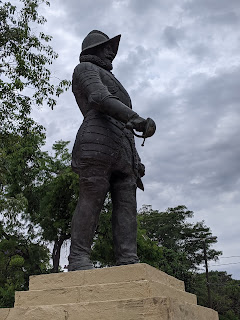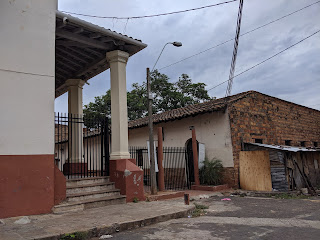When we're at home in Denver, I normally walk down to our nearby Catholic church on Sunday mornings to attend Mass before then walking with a friend in the neighborhood. Since Steven and I couldn't see the interior of Asuncion's Metropolitan Cathedral the day before, it seemed only fitting to return on the Sunday morning for Mass. First, though, we stopped to look at the rather stark Catholic University of Asuncion immediately next to the cathedral.
After spending two plus days trying to see what passed for Asuncion's sights, we were less than overwhelmed or terribly impressed by what we'd seen. That was an absolute rarity for us as we normally are intrigued by, and marvel at, much of what we get to see in a new city. Now, almost two months later, though, we are still huge fans of the Museo del Barro, the museum we'd toured the day before. That remains the one and only highlight for us in Paraguay's capital city. We certainly hoped that our tour of so much of the rest of Paraguay in the coming week would be far more enjoyable than of its capital!
Next post: Touring the very unusual Museum of Chairs before embarking on a tour away from Asuncion.
Posted on February 4th, 2020, from our home in Denver after the city's only snowstorm since arriving back almost seven weeks ago!
Just to the left of the university was unimaginable squalor, the likes of which we'd rarely seen anywhere in the world. To witness the poverty-stricken area just a few feet from the cathedral was almost unbearable. The juxtaposition of the two Catholic institutions next to such abject poverty was heartbreaking. I felt almost ashamed of being Catholic, at a loss to understand how the church's teachings had obviously failed those in such dire need just steps away.
The cathedral, as you may recall from the preceding post, anchored one side of the large Plaza de Independencia also known as the Plaza de Armas. The cathedral attained its finest hour in March of 1999 when it became a temporary hospital for wounded and dying demonstrators protesting the assassination of the country's then Vice President. After eight demonstrators opposed to the government were killed in what became known as the Marzo Paraguayo or the Paraguay March, a banner with the names of the martyrs was hung on one of the cathedral's towers.
In front of the cathedral was a stone bas-relief of Domingo Martinez de Irala who led the first Spanish settlement in Asuncion. He was shown embracing a group of indigenous people while a paper with the plan of the cathedral is at their feet. The gift from a former Spanish ambassador has been criticized because the Spanish forcibly exploited the indigenous and reduced them to almost slavery, and, even though they married indigenous women when 80 percent of the population was wiped out in the Triple Alliance War, the foreigners had no choice in the matter.
The plaque in the church's porch was a reminder of the important 1603 Synod of Asuncion which established the policy for evangelizing the indigenous in their own language. That laid the basis for the work of the Jesuit and Franciscan missions in Paraguay.
Unlike most cathedrals we've seem this one had a flat wooden roof. It appeared that one of the priests was either hearing confessions or counseling parishioners in one of the pews before the day's only Mass at 11.
There couldn't have been more than a hundred people attending Mass which seemed very low for quite possibly the week's only Mass.
The finest artwork was the altar with its ornate silver panels.
Musical accompaniment was provided by a guitarist and organist. The Mass wasn't very peaceful and serene with urchins from the slums virtually next door running up and down the porch and then in the church itself.
After not finding the Monument to the Marzo Paraguayo the day before in the park across the street, we looked again after church and located it. I think we'd both been on the lookout for something a lot larger than this simple cross and stone plaque in the ground that was supposed to honor the dead and 700 wounded. The black slab said, "They gave their lives to make us free." Many of the park's black and white tiles had been tossed by the mostly student demonstrators against government forces. It seemed either that many of them had never been replaced in the last 20 years or were subsequently removed as many were absent.
From one of the city's few highrises, snipers had shot into the crowd of demonstrators, killing eight.
Directly behind the almost paltry monument was a statue of Juan de Salazar y Espinosa who founded Asuncion on August 15th, 1537.
At the back of the Cathedral was the attractive alley, called the Paseo Comuneros, named after the revolutionary movement that preceded Paraguay's independence in 1811. We'd hoped to visit the Museo Bogarin located in the alley as it was supposed to be packed full of items of great historical and artistic interest but apparently it had been closed for some time.
The entire area was in desperate need of sprucing up and a serious investment of money as it was pretty scary walking around to reach the alley.
We headed next toward the House of Jose Asuncion Flores, a famous Paraguayan musician who created the musical form of guarania, named after the indigenous people, the country's second official language and the money. As you can see, the walk wasn't along the capital city's better streets. I remember wondering whether we really wanted to go to Flores' house, given the condition of the neighborhood.
Looking at the glass half full, however, the murals we saw were very colorful.
A local woman walking by with her about-ten-year old daughter took one look at us and asked us in almost perfect English whether we would like her daughter to walk us to the Flores' house. That was so incredibly thoughtful. We declined but thanked her profusely for the kind offer. Several minutes later, we walked past a man working in his garage who also asked if he could help us!
This mosaic mural was of a Paraguayan bird called el chogui and was subsequently made into a song.
We were naturally pretty disappointed when we finally reached Flores' house only to find it closed.
We consoled ourselves looking at the views.
Another woman saw us and figured we could only be there to look at the Flores' house and offered to open up the small museum for us as she had a key for just those situations when tourists wandered by. That was the first of what turned out to be many, many examples of locals having keys to churches and museums that otherwise were closed when we began touring southern Paraguay with our guide, Jose, beginning the following morning! The custom, we knew, was to generously tip the caretaker as there was no admission price.
Flores' adobe house had been restored and housed a small library with mementos of the fabled artist's career.
Pictures showed the extensive renovations that had taken place before it was opened to the public
On the way back to the center of town, I almost fell over backwards when I spotted a Little Free Library in such a desperately poor part of town.
As much as we didn't love Asuncion for a whole slew of reasons, we still had to give the city, or, perhaps some of its citizens, credit for a few signs of hope we came across like these plans for the future and the attractive mosaics around Flores' neighborhood. We couldn't say some weren't trying!
Restoration was also taking place at the former train station.
We read that Plaza Uruguaya next to the train station had been improved in May of 2012 after years of being used by prostitutes and thieves, then as a campsite by indigenous people protesting against the government. High railings were installed so the park was only open certain hours.
The Italian statues in the Romantic style dated from 1885.
Like most of downtown Asuncion, the park had free WiFi.
We thought the statue in the park was likely of the great Uruguayan politician, Jose Artigas, in thanks for his country's return of trophies after the Triple Alliance War. However, the name, if it were Artigas', had been erased! It was just another example of their seeming to be too little money to maintain the city's sights.
In the park was likely the most unusual bookstore we'd ever seen. A sign on it said, "To know is to read."
We'd hoped to sit on a park bench for a bit as we were struggling to figure out what else to see but there were many homeless people sleeping on them.
It was almost comical seeing the approximately 20 different varieties of mayo in a small grocery store near the park!
To commemorate the bicentennial of Paraguay's independence in 2011, six historic houses in Asuncion were bought as part of the country's heritage. Four were restored and opened to be devoted to the arts. Across from Plaza Uruguaya was the French-designed Casa Bicentenario de la Literatura. It, too, was closed but we were able to peek through the grating to spot the portraits of the five Proceres de la Independencia, those who had fought for their country's independence.
The home, built in the early 1800s, was part of the Convento de San Francisco until all religious orders were banned in 1824 in Paraguay. It then become a military barracks before finally becoming a center for literature with exhibition rooms for books and items belonging to Paraguay's most famous novelist.
A couple of blocks away was the San Franciscan Church but, like almost everything else that day, it was also closed.
I don't remember seeing any sign indicating who was being honored on the side of this building.
The Teatro Municipal was re-opened in 2006 after an extensive restoration.
The previous day, Steven and I had looked in vain for the entrance to the Manzana de la Rivera, a block of interlinked houses directly opposite the Palacio de Lopez. We didn't realize then, the entrance was actually around the corner to the art and study center.
These two-story offices in the Manzana belonged to UNESCO. Like practically everything else that day, the museums in the Manzana were, of course, closed!
Hoping to find something open, we walked toward the port thinking that the arcade of craft shops known as Le Recova might be open. I read that, like much in Asuncion, "this had a quaint charm in an old-fashioned, run-down way." I think that was a very optimistic view as it was all pretty depressing. All we saw was one homeless man in the arcade's rather shabby buildings.
We'd wandered around for over six miles for the second day in a row but we sure hadn't broken any speed records as it was at a very slow pace which seemed to match the cloudy and somewhat drizzly day! Not only were virtually all the city's sights closed on the Sunday, restaurants were, too, for some strange reason. We were left with only being able to grab some grilled cheese sandwiches and a lemon tart at the local gas station's cafe. Frequent readers of this blog know Steven and I aren't foodies, but even we would have preferred something more substantial than a sandwich for dinner.
Next post: Touring the very unusual Museum of Chairs before embarking on a tour away from Asuncion.
Posted on February 4th, 2020, from our home in Denver after the city's only snowstorm since arriving back almost seven weeks ago!


































































No comments:
Post a Comment